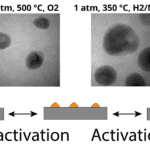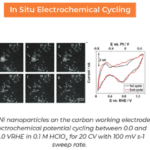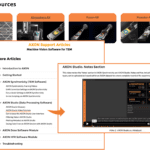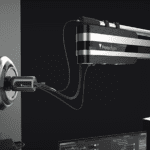
Do you want to correlate your catalyst activity to the nanoscale behavior? In catalysis research, observing catalysts before and after the reaction is very important. However, this gives us limited information about structural changes of catalysts materials during reactions.
With Atmosphere AX from Protochips, you can observe the structural and functional evolution of catalysts at the nanoscale in real time with the transmission electron microscope (TEM), under relevant gaseous conditions and up to 1 atmosphere and 1000°C. So how are you able to observe the selectivity of your catalyst using our systems?
- Preparation: During sample preparation, it is of the utmost importance that your sample can be safely inserted in the microscope. This is why the Atmosphere AX system comes with proactive pressure monitoring which will shut down the system if leaks are detected! To further support TEM safety, Protochips streamlines system maintenance/cleaning, without system disassembly by doing bake-outs at 50 °C as the internal lines are all made of stainless steel. This removed any contaminants from the lined and will therefore offer a high precision.
- Collection: Once Atmosphere AX is fully set up and TEM-ready, gas flow can be initiated. Both gas flow and heating can trigger sample movement, therefore Atmosphere AX comes equipped with machine vision software, AXON Synchronicity, providing live physical and digital correction as well as metadata indexing and integration.
- Analysis: In addition to observing structural evolution of catalysts, the gas composition contains information on our catalyst activity. This is why the Atmosphere AX system can be equipped with our ultra quiet residual mass spectrometer (RGA). The RGA has fast gas detection times (< 3 seconds) with no compromise image resolution as there is no rough pump installed.
- Publishing: If all the data has been collected and analyzed, data processing can begin. With the free processing software, AXON Studio, any stakeholder can filter, plot, sort, create videos and images after an experiment is completed. As all the data is integrated, it is easy to identify trends and see results instead of having to scroll through many folders or manually correlate all the data.
Using this workflow you are guaranteed to be able to scale your bulk catalysts experiments to the nanoscale, while doing this productively and reproducibly and being able to share and filter data easily using the FAIR principle methods.
Want to know more about heterogeneous catalysis using in situ microscopy? Look up our brochure online!

In the images you can observe the activity of two Fisher-Tropsch catalysts (Co/SiO2 top and Co/Al2O3 bottom) and their different particle sizes. The silica supported catalyst underwent a higher degree of reduction, which made it quicker to activate for the CO conversion, followed by the RGA.

Find the full research paper here:
https://onlinelibrary.wiley.com/doi/abs/10.1002/cctc.202001074









